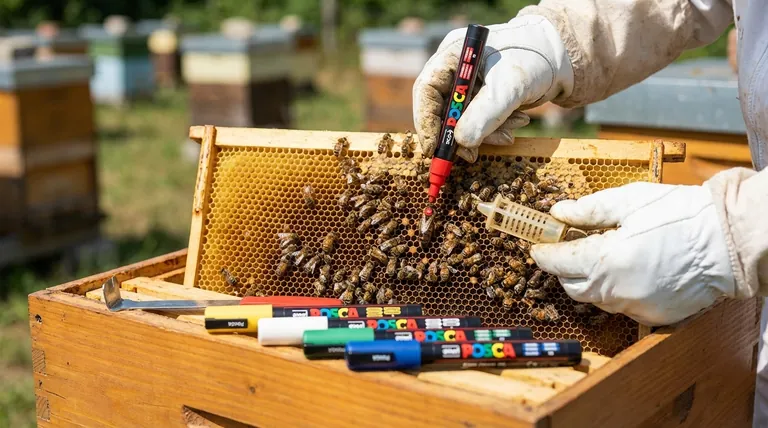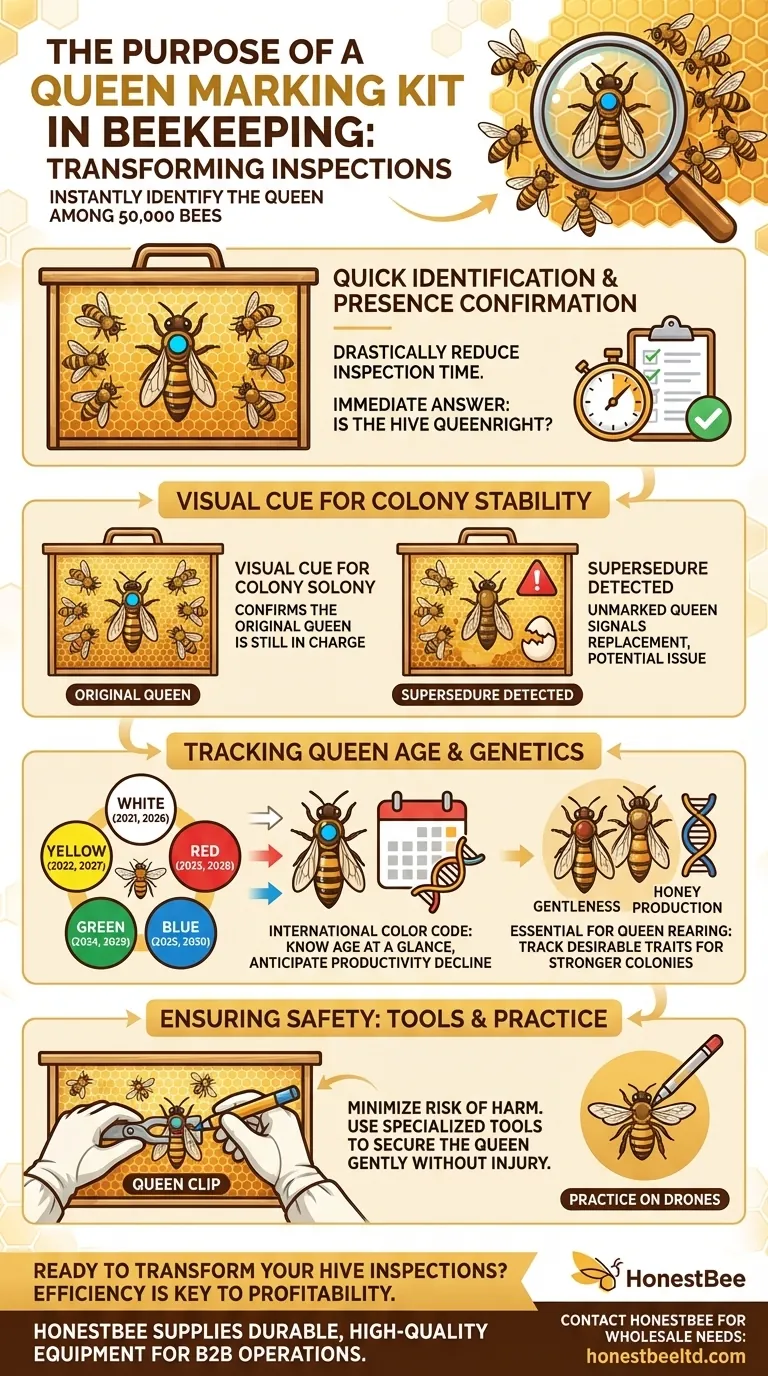In short, a queen marking kit is used to place a small, colored dot on a queen bee. This simple act makes her instantly identifiable among the tens of thousands of other bees in the hive, which is critical for efficient and effective colony management. The mark allows beekeepers to quickly assess her presence, age, and lineage during hive inspections.
The true purpose of marking a queen isn't just about finding her faster. It's about transforming a chaotic hive inspection into a quick, data-driven assessment of the colony's health, stability, and productivity.

Why Marking the Queen is a Critical Practice
A healthy beehive can have over 50,000 individual bees. Finding the single most important bee—the queen—can feel like an impossible task. Marking her solves this fundamental challenge and provides immediate, valuable information.
The Challenge of Locating the Queen
Without a mark, a beekeeper must scan frame after frame, searching for a single bee that is only slightly larger than the others. This process is time-consuming and stressful for both the beekeeper and the colony.
A brightly colored dot on the queen's thorax (the middle section of her body) makes her stand out immediately. This drastically reduces the time needed for an inspection, minimizing disruption to the hive.
Instantly Confirming Her Presence
The most important question during any hive check is: "Is the queen present and laying?" If you can spot the marked queen, you have an immediate and definitive answer.
This confirmation tells you the hive is "queenright" and functioning correctly. If you can't find her, it's an early signal that you may have a serious problem, such as the colony having swarmed or the queen having failed.
A Visual Cue for Colony Stability
Seeing the same marked queen on subsequent inspections confirms that the original queen is still in charge.
If you suddenly see an unmarked queen, you know the colony has replaced her through a process called supersedure. This is vital information, as it indicates a potential issue with the previous queen's health or performance.
The Strategic Value of Information
Marking goes beyond simple identification. The color of the mark is a code that provides strategic data about the queen's history and the hive's long-term potential.
Tracking the Queen's Age
There is an international color code used by beekeepers that corresponds to the year the queen was born. This system allows you to know a queen's age at a single glance.
A queen's egg-laying productivity typically declines after two or three years. Knowing her age helps you anticipate this decline and plan to replace her before the colony's population and productivity suffer.
Aiding in Genetic Management
For beekeepers who raise their own queens (queen rearing), marking is essential. It allows them to track queens with desirable traits, such as gentleness, disease resistance, or high honey production.
This ensures that the best genetics are propagated throughout the apiary, leading to stronger and more successful colonies over time.
Understanding the Trade-offs and Risks
While marking is overwhelmingly beneficial, the process itself requires care and carries a small but significant risk. The primary goal is to mark the queen without causing her any harm or stress.
The Risk of Harming the Queen
The queen is fragile. Mishandling her can easily damage a leg, an antenna, or even her abdomen, which can be fatal. Applying too much paint can also interfere with her movement or breathing.
For this reason, many beekeepers practice on drones (male bees) before ever attempting to mark a queen.
Using Tools to Ensure Safety
To minimize risk, beekeepers often use special tools to gently secure the queen during the marking process.
Queen clips or small cages can be used to isolate her on the frame, allowing the beekeeper to apply the paint dot safely without having to pick her up by hand. This reduces the chance of injury and minimizes stress on the queen.
Making the Right Choice for Your Goal
Deciding to mark your queens depends on your beekeeping objectives.
- If your primary focus is efficiency: Marking your queens is one of the single best things you can do to speed up inspections and reduce hive disruption.
- If your primary focus is performance and genetics: Marking with the correct year-specific color is non-negotiable for tracking queen age and productivity.
- If you are a new beekeeper and feel nervous: It is acceptable to wait, but understand that finding an unmarked queen is a major challenge that can make learning more difficult.
Ultimately, marking your queen is a simple action that provides a wealth of information, turning you from a reactive bee-haver into a proactive colony manager.
Summary Table:
| Purpose | Key Benefit |
|---|---|
| Quick Identification | Instantly find the queen among thousands of bees. |
| Confirm Queen Presence | Immediate verification of a healthy, "queenright" hive. |
| Track Queen Age | Use the international color code to monitor productivity. |
| Manage Genetics | Identify and propagate queens with desirable traits. |
Ready to transform your hive inspections?
For commercial apiaries and distributors, efficient colony management is key to profitability and productivity. A reliable queen marking kit is fundamental to this process.
HONESTBEE supplies the durable, high-quality beekeeping equipment you need to manage your operations effectively. Let us help you equip your business for success.
Contact HONESTBEE today to discuss your wholesale supply needs.
Visual Guide

Related Products
- Queen Bee Marking Pen POSCA Queen Marking Pens for Beekeeping Bee Markers
- Queen Bee Marking Pen UNI Medium Point for Queen and Bee Marking
- Professional Engraved Round Hive Number Tags for Beekeeping
- Jenter Queen Rearing Kit Complete Set for Bee Breeding
- No Grafting Queen Rearing Kit: System for Royal Jelly Production and Queen Rearing
People Also Ask
- What should you do immediately after marking a bee? Ensure a Clean, Durable Mark with This Key Step
- What are the benefits of marking a queen bee? Boost Efficiency & Hive Health
- What type of markers are commonly used for marking Queen bees? Choose the Safe, Non-Toxic Standard
- What are the Queen marking colors associated with specific years? Master Hive Management with the 5-Year Color Code
- What are the benefits of marking a Queen bee for hive management? Boost Efficiency & Colony Health



















